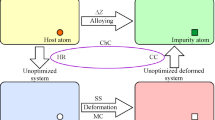Abstract
The effect of 3d–5d elements on the oxygen adsorption energy on the NiTi(110) surface has been studied by the projector augmented-waves method within density functional theory. It is shown that almost all elements, except for a few elements of the end of d periods, lead to an increase in the adsorption energy if they substitute for nickel. On the contrary, the substitutional impurities in the titanium sublattice lower this energy. Based on the analysis of the electronic characteristics of the surface with impurities, it has been found that an increase/decrease in the oxygen adsorption energy on NiTi(110) correlates with a change in the ionic contribution to the mechanism of oxygen bonding with the surface.






Similar content being viewed by others
REFERENCES
S. A. Shabalovskaya, J. Anderegg, and J. Van Humbeeck, Acta Biomater. 4, 447 (2008).
H. Tian, D. Schryvers, D. Liu, et al., Acta Biomater. 7, 892 (2011).
S. E. Kulkova, A. V. Bakulin, Q. M. Hu, et al., Phys. B (Amsterdam, Neth.) 426, 118 (2013).
A. V. Bakulin, T. I. Spiridonova, and S. E. Kulkova, Comput. Mater. Sci. 148, 1 (2018).
V. G. Pushin, V. V. Kondrat’ev, and V. N. Khachin, Transients and Martensitic Transformations (UrO RAN, Yekaterinburg, 1998) [in Russian].
P. E. Blöchl, Phys. Rev. B 50, 17953 (1994).
G. Kresse and D. Joubert, Phys. Rev. B 59, 1758 (1999).
G. Kresse and J. Hafner, Phys. Rev. B 48, 13115 (1993).
G. Kresse and J. Furthmüller, Comput. Mater. Sci. 6, 15 (1996).
J. P. Perdew, K. Burke, and M. Ernzerhof, Phys. Rev. Lett. 77, 3865 (1996).
H. J. Monkhorst and J. D. Pack, Phys. Rev. B 13, 5188 (1976).
E. A. Brandes and G. B. Brook, Smithells Metals Reference Book, 7th ed. (Butterworth–Heinemen, London, 1992).
M. Nolan and S. A. M. Tofail, Biomaterials 31, 3439 (2010).
A. V. Bakulin, S. E. Kulkova, Q. M. Hu, and R. Yang, J. Exp. Theor. Phys. 120, 257 (2015).
M. Pohl, T. Glogowski, S. Kühn, et al., Mater. Sci. Eng. A 481–482, 123 (2008).
W. Tang, E. Sanville, and G. Henkelman, J. Phys.: Condens. Matter 21, 084204 (2009).
N. G. Limas and T. A. Manz, RSC Adv. 6, 45727 (2016).
T. A. Manz and N. G. Limas, RSC Adv. 6, 47771 (2016).
A. V. Bakulin and S. E. Kulkova, J. Exp. Theor. Phys. 127, 1046 (2018).
S. E. Kulkova, A. V. Bakulin, Q. M. Hu, et al., Mater. Today: Proc. 2S, 615 (2015).
B. Hammer and J. K. Nørskov, Surf. Sci. 343, 211 (1995).
V. E. Egorushkin, S. E. Kul’kova, N. V. Mel’nikova, and A. N. Ponomarev, J. Exp. Theor. Phys. 101, 350 (2005).
R. Dronskowski and P. E. Blöchl, J. Phys. Chem. 97, 8617 (1993).
S. Maintz, V. L. Deringer, A. L. Tchougreeff, et al., J. Comput. Chem. 37, 1030 (2016).
S. E. Kulkova, A. V. Bakulin, S. S. Kulkov, et al., Phys. Scr. 90, 094010 (2015).
F. P. Ping, Q. M. Hu, A. V. Bakulin, et al., Intermet. 68, 57 (2016).
G. S. Firstov, R. G. Vitchev, H. Kumar, et al., Biomaterials 23, 4863 (2008).
Funding
This work was supported by project III.23.2.8 of the Institute of Strength Physics and Materials Science, Siberian Branch, Russian Academy of Sciences, and partly by the Russian Foundation for Basic Research (grant no. 18-03-00064_a) and Tomsk State University Competitiveness Improvement Program. Calculations were carried out using a supercomputer SKIF-Cyberia in Tomsk State University.
Author information
Authors and Affiliations
Corresponding author
Additional information
Translated by A. Zeigarnik
Rights and permissions
About this article
Cite this article
Bakulin, A.V., Kulkova, S.E. Effect of Impurities on the Oxygen Adsorption Properties on the NiTi(110) Surface. J. Exp. Theor. Phys. 129, 413–420 (2019). https://doi.org/10.1134/S1063776119070033
Received:
Revised:
Accepted:
Published:
Issue Date:
DOI: https://doi.org/10.1134/S1063776119070033



